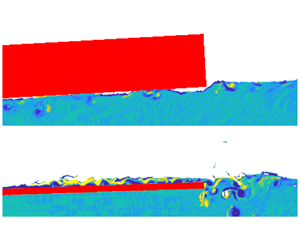Crossref Citations
This article has been cited by the following publications. This list is generated based on data provided by
Crossref.
Wu, Tiecheng
Luo, Wanzhen
Jiang, Dapeng
Deng, Rui
and
Huang, Shuo
2020.
Numerical Study on Wave-Ice Interaction in the Marginal Ice Zone.
Journal of Marine Science and Engineering,
Vol. 9,
Issue. 1,
p.
4.
Tran-Duc, Thien
Meylan, Michael H.
Thamwattana, Ngamta
and
Lamichhane, Bishnu P.
2020.
Wave Interaction and Overwash with a Flexible Plate by Smoothed Particle Hydrodynamics.
Water,
Vol. 12,
Issue. 12,
p.
3354.
Koley, Santanu
2020.
Water wave scattering by floating flexible porous plate over variable bathymetry regions.
Ocean Engineering,
Vol. 214,
Issue. ,
p.
107686.
Vyzikas, Thomas
Stagonas, Dimitris
Maisondieu, Christophe
and
Greaves, Deborah
2020.
Intercomparison of Three Open-Source Numerical Flumes for the Surface Dynamics of Steep Focused Wave Groups.
Fluids,
Vol. 6,
Issue. 1,
p.
9.
Li, Jian
Yuan, Yi
Wang, Jiao
Bao, Ronghao
and
Chen, Weiqiu
2021.
Propagation of nonlinear waves in graded flexible metamaterials.
International Journal of Impact Engineering,
Vol. 156,
Issue. ,
p.
103924.
Anderson, Stuart
2021.
Remote Sensing of the Polar Ice Zones with HF Radar.
Remote Sensing,
Vol. 13,
Issue. 21,
p.
4398.
Meylan, Michael H.
2021.
Time-Dependent Motion of a Floating Circular Elastic Plate.
Fluids,
Vol. 6,
Issue. 1,
p.
29.
Kostikov, Vasily K.
Hayatdavoodi, Masoud
and
Ertekin, R. C.
2021.
Drift of elastic floating ice sheets by waves and current, part I: single sheet.
Proceedings of the Royal Society A: Mathematical, Physical and Engineering Sciences,
Vol. 477,
Issue. 2254,
Khuntia, Sagarika
Mohapatra, Smrutiranjan
and
Bora, Swaroop Nandan
2021.
Analytical study of wave diffraction by an irregular surface located on a flexible base in an ice-covered fluid.
Meccanica,
Vol. 56,
Issue. 2,
p.
335.
Zhao, Xuanlie
Du, Xin
Li, Mingwei
and
Göteman, Malin
2021.
Semi-analytical study on the hydrodynamic performance of an interconnected floating breakwater-WEC system in presence of the seawall.
Applied Ocean Research,
Vol. 109,
Issue. ,
p.
102555.
Skene, David M.
and
Bennetts, Luke G.
2021.
A Transition-Loss Theory for Waves Reflected and Transmitted by an Overwashed Body.
SIAM Journal on Applied Mathematics,
Vol. 81,
Issue. 3,
p.
834.
Kim, Sung-Jae
Kim, Moo-Hyun
and
Koo, Weoncheol
2021.
Nonlinear hydrodynamics of freely floating symmetric bodies in waves by three-dimensional fully nonlinear potential-flow numerical wave tank.
Applied Ocean Research,
Vol. 113,
Issue. ,
p.
102727.
Voermans, Joey J.
Liu, Qingxiang
Marchenko, Aleksey
Rabault, Jean
Filchuk, Kirill
Ryzhov, Ivan
Heil, Petra
Waseda, Takuji
Nose, Takehiko
Kodaira, Tsubasa
Li, Jingkai
and
Babanin, Alexander V.
2021.
Wave dispersion and dissipation in landfast ice: comparison of observations against models.
The Cryosphere,
Vol. 15,
Issue. 12,
p.
5557.
Meylan, Michael H.
Horvat, Christopher
Bitz, Cecilia M.
and
Bennetts, Luke G.
2021.
A floe size dependent scattering model in two- and three-dimensions for wave attenuation by ice floes.
Ocean Modelling,
Vol. 161,
Issue. ,
p.
101779.
Marquart, Rutger
Bogaers, Alfred
Skatulla, Sebastian
Alberello, Alberto
Toffoli, Alessandro
Schwarz, Carina
and
Vichi, Marcello
2021.
A Computational Fluid Dynamics Model for the Small-Scale Dynamics of Wave, Ice Floe and Interstitial Grease Ice Interaction.
Fluids,
Vol. 6,
Issue. 5,
p.
176.
Park, Sung Boo
Shin, Seong Yun
Shin, Da Gyun
Park, Hyunjung
Jung, Kwang Hyo
Suh, Sung Bu
Lee, Jaeyong
Lee, Seung Jae
and
Kim, Hyun Soo
2022.
Experimental study of wave transmission and drift velocity using freely floating synthetic ice floes.
Ocean Engineering,
Vol. 251,
Issue. ,
p.
111058.
Cooper, V. T.
Roach, L. A.
Thomson, J.
Brenner, S. D.
Smith, M. M.
Meylan, M. H.
and
Bitz, C. M.
2022.
Wind waves in sea ice of the western Arctic and a global coupled wave-ice model.
Philosophical Transactions of the Royal Society A: Mathematical, Physical and Engineering Sciences,
Vol. 380,
Issue. 2235,
Passerotti, Giulio
Bennetts, Luke G.
von Bock und Polach, Franz
Alberello, Alberto
Puolakka, Otto
Dolatshah, Azam
Monbaliu, Jaak
and
Toffoli, Alessandro
2022.
Interactions between Irregular Wave Fields and Sea Ice: A Physical Model for Wave Attenuation and Ice Breakup in an Ice Tank.
Journal of Physical Oceanography,
Vol. 52,
Issue. 7,
p.
1431.
Tran-Duc, Thien
Meylan, Michael H.
and
Thamwattana, Ngamta
2022.
Dynamical response of a floating plate to water waves using a smoothed particle hydrodynamics algorithm for nonlinear elasticity.
Physics of Fluids,
Vol. 34,
Issue. 5,
Huang, Longwei
Lu, Wenyue
Yang, Jianmin
and
Dong, Qing
2022.
Experimental study on surface waves around a novel model of ice floe.
Cold Regions Science and Technology,
Vol. 193,
Issue. ,
p.
103380.





